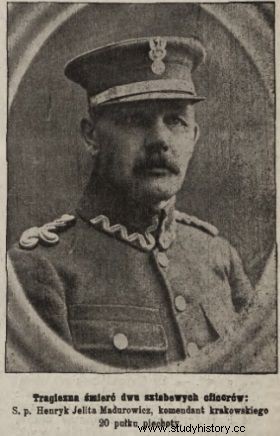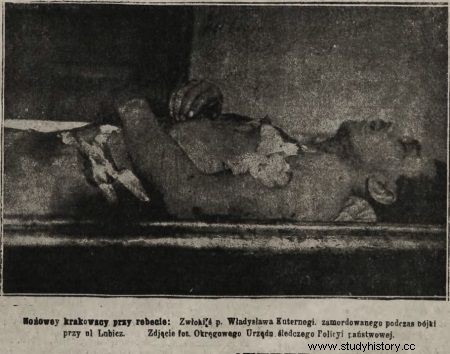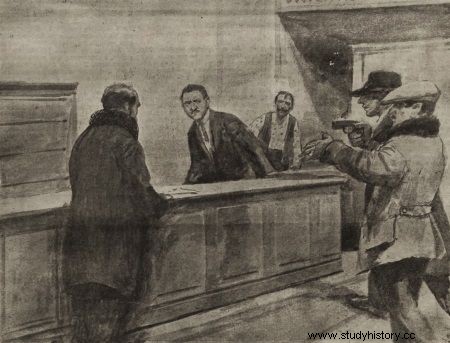b> For Stanisław Kisielewski, disputes with his superiors were daily bread. One day the commander of his unit - the 6th regiment of mounted riflemen - marched into the stables and again began to reproach the unfortunate sergeant. For disorder, clumsiness, disrespect for service ... Measure changed. Kisielewski reached for a revolver and laid the body of Lieutenant Colonel Obiedziński.
Without thinking, he killed his colleague, Sergeant Jan Gadomski, and then ran out of the stable and put a revolver in his mouth. He pulled the trigger, but his hand trembled at the last moment - as a result, the bullet pierced his cheek, and the man survived and was taken to the hospital. The "Illustrated Daily Kuryer" of May 11, 1926, wrote about this incident only on the seventh page. And no wonder - there were lots of similar cases.
The pre-war Republic of Poland kept one of the largest armies in Europe on standby. Its ranks consisted of between 280,000 and 290,000 soldiers and sailors. No wonder that not all of them were the flawless gentlemen that are swarming with glazed stories about the Second Polish Republic. The harsh reality was that very few soldiers settled disputes in duels and according to the codes of honor. Most resorted to ordinary fights and murder.

Ruthless, decisive and deadly. The most famous criminals of pre-war Poland in the book by Kamil Janicki "Fallen ladies of the Second Republic". Buy with a discount on empik.com.
Soldier's honor for 5 zlotys
A typical scene took place in May 1931 in the "Kometa" restaurant in Łódź. Two soldiers, sergeant Jan Filipiak and senior sergeant Franciszek Laskowski argued about how the bill for a few hours of drinking should be divided. The party of playing privates was not permanent; some came, others left, and yet someone had to pay for everything. Laskowski was indignant that he had only been drinking for a short while and was expected to pay for what "came" earlier .
"Dziennik Łódzki" reported: At one point, Laskowski took out a revolver and fired , injuring Sergeant Balcerzak - who was not involved in the quarrel at all! - in my hand. Those present tried to disarm Laskowski, but he shot twice more and both bullets hit Gawroński - another innocent witness to a brawl - who collapsed on the floor and soon gave up his ghost.
Gawroński was a second lieutenant in the reserve, so the matter was serious:the murder of an officer! However, the court turned out to be exceptionally lenient and sentenced Laskowski to a wasted five months in the fortress. It was argued in the verdict that the perpetrator had acted in heavy drunkenness with alcohol. In this case, the most shocking factor is the amount for which Laskowski killed one soldier and wounded another. It was a stupid five zlotys.

The murder at the Kometa restaurant. Excerpt from the article in "Dziennik Łódzki" summarizing the case.
A more mysterious tragedy happened in Krakow in 1921. At the end of June, Major Zdzisław Trześniowski came to the office of the 20th infantry regiment in Krowodrza, demanding a meeting with the commander. The commander was not in the unit, so the major lowered the requirements - he said that seeing the lieutenant colonel was enough for him. He was admitted into the office. A minute or two has passed when:
The orderly heard the sound of a series of shots coming from the chancellery, and as they hurried there they saw a terrible, chilling sight. The corpses of both officers lay dead on the floor in a pool of their own blood . (...) What was the cause of the incident and what was its course is covered by the eternal secret that both victims took with them to the grave. It is only certain that the late Lieutenant Colonel Madurowicz fell at the hand of the late Major Trześniowski.
This is how "Illustrated News" reported. The journalist of the magazine praised the attributes of the murdered lieutenant colonel straight to the heavens. He was said to be a flesh-and-blood soldier with a conscience as clear as a tear. And Trześniowski? Surprisingly, the editor did not blame him too much, as if he was completely used to similar incidents. He only regretted that the major had fallen a victim of the momentary blackout, which had crushed a murderous and suicide weapon into his hand, and was undoubtedly a consequence of the harsh experiences of the war.
It turns out that Laskowski was a drunk, Kisielewski a madman, and Trześniakowski - without mincing words - a madman. However, in the great mass of people, which was the Polish Army, there were also the most ordinary scumbags. This fact is perfectly illustrated by the history from the very beginning of the Second Polish Republic.

"The tragic death of two officers." Lieutenant Colonel Madurowicz in a photo published by "Nowości Illustrowane".
A military Christmas Eve story
On Christmas Eve 1921, a sudden alarm caused the inhabitants of Biała Podlaska to jump to their feet. Families were already getting ready for the Christmas supper when a fire broke out in the "Castle" in the city center. The local newspaper "Podlasiak" reported:
Indeed, an enormous glow on the western horizon indicated that the fire was of great size (...). She arrived quite late and the local volunteer fire brigade did not extinguish the fire due to the lack of appropriate rescue equipment. The main pavilion was almost completely burnt down. Two days after the fire, the ashes were smoldering.
A coincidence as the cause of the fire was quickly ruled out. It turned out that a group of soldiers was behind everything. On the eve of Christmas Eve, the commander of the local telegraph department, Lieutenant Dropiński, was arrested on charges of theft and abuse. His subordinates apparently felt that the ground was burning under their feet and decided to cover up all traces of the crimes. They deliberately organized a Christmas party for the rest of the soldiers, got them drunk, and when they started to stagger, they locked the building's door. Then they set fire to the "Castle" in four places:in the office, in the attic, under the main and side stairs. All this just so that the files in the office could not be saved in any way.
Fortunately, the trapped soldiers managed to get out of it before the fire consumed the building. No one was killed, but many families living in the area lost their homes. The sergeants did not achieve their goal - they were arrested and placed at the disposal of a military tribunal.
In this case, it was about some coarser scam, but the soldiers often committed quite common crimes as well. For example, in February 1936, Stanisław Barysz, a private from the 20th infantry regiment stationed in Krakow, burst into the apartment of a certain Józefa Marsowa, the wife of another soldier. Barysz had some settlements with Mars (or maybe with her spouse) and ruthlessly stabbed the woman with a bayonet.
He also killed one of her sublime teachers - a prostitute, by the way. He was quickly arrested because two more tenants of the victim passed in the door of the tenement house. He stood trial before a military court and was sentenced to death. The case was so typical that it is hard to believe that it made it to the third page of the newspaper.

Krakow has had a problem with cutters for a long time. The photo shows the victim of an unidentified murderer in uniform.
Bolshevik call
The diaries preferred to write about the worst possible scum:sworn functionaries of the Commonwealth who decided to betray their homeland for money or lying ideas. And they didn't even have to kill anyone to get to the front or back of the number! Take the example of constable Michał Dynak working in Rivne, who in May 1932 caused a real sensation in the capital's newspapers. It was enough that he escaped from Poland, and "Nowiny Codzienne" already wrote in half a column:
Taking advantage of the holiday, he entered the office and, having opened the closets and the office with counterfeit keys, stole the seals and important files. Then he took a hired taxi to the Soviet border and passed it near Cordoba, handing himself over to the Bolshevik authorities . The reasons for Dynak's treacherous act are unknown (...) he was always very diligent, was of a quiet nature and gave nothing to betrayal.
You know. It is the quiet and the calm who are always the most dangerous ... At the end of this short explanation about the uniforms, it is worth mentioning that the multitude of military crimes was definitely useful to the criminal underworld.

The robbery of the exchange office. A typical "soldier" action?
The bandits of the interwar period quickly realized that the military uniform was a perfect disguise! They were attacking money changers, jewelers and peasant farms in the clothes of the soldiers who had been smoked out (or those preserved from their own service). The victims reportedly felt more respect when a lieutenant aimed a pistol at their heads. Besides, it was more difficult to recognize such a delinquent later. Who attacked you? Aaaah, some military man in an officer's cap! - victims answered questions from the police.
In practice, these military men usually had absolutely nothing to do with the army. For example, in 1920, the famous attack on the Krakow currency dealer Jakub Grünfeld was perpetrated by three men in military uniforms with revolvers in their hands. After an intricate investigation, it turned out that all three were in fact robbers and recidivists who had just escaped from prison ...
Sources:
The article is based on source materials and literature collected during the work on the book "Upadłe damy II Rzeczpospolitej". You can buy the book with a discount at empik.com .
Buy the book (much) cheaper than others:
